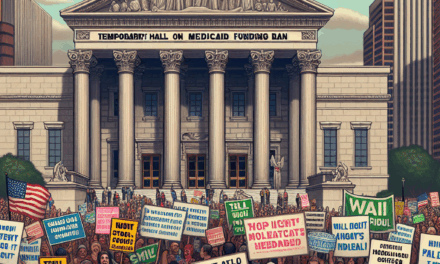Trump Unveils 2026 Budget Proposal with Significant Healthcare Reductions
In a move that has sparked considerable debate and concern, former President Donald Trump has unveiled his budget proposal for 2026, which includes substantial reductions in healthcare funding. This proposal, which aims to reshape the landscape of American healthcare, has implications for millions of Americans who rely on government programs for their medical needs. This article will explore the key components of Trump’s budget proposal, the potential impacts on healthcare services, the political ramifications, and the broader implications for the American public.
Overview of the 2026 Budget Proposal
Trump’s 2026 budget proposal is characterized by a focus on reducing federal spending, with healthcare being one of the most affected sectors. The proposal outlines a plan to cut funding for various healthcare programs, including Medicaid, Medicare, and the Affordable Care Act (ACA). The rationale behind these cuts is to reduce the national deficit and promote fiscal responsibility.
Key highlights of the budget proposal include:
- Significant cuts to Medicaid funding, which provides healthcare for low-income individuals and families.
- Reductions in Medicare spending, particularly affecting services for seniors.
- Elimination of certain provisions of the Affordable Care Act, which could lead to increased premiums and reduced coverage for millions.
- Increased funding for health savings accounts (HSAs) to encourage personal responsibility in healthcare spending.
- Proposals to streamline administrative costs in healthcare delivery systems.
These proposed changes have raised alarms among healthcare advocates, economists, and political analysts, who argue that such cuts could have dire consequences for vulnerable populations.
Impact on Medicaid: A Closer Look
Medicaid, the government program that provides health coverage to low-income individuals and families, is one of the most significant areas affected by Trump’s budget proposal. The proposed cuts to Medicaid funding could lead to millions losing their health coverage, exacerbating health disparities across the nation.
According to the Kaiser Family Foundation, approximately 82 million Americans were enrolled in Medicaid as of 2021. This program is crucial for various demographics, including children, pregnant women, the elderly, and individuals with disabilities. The proposed reductions could manifest in several ways:
- Eligibility Restrictions: The budget proposal suggests tightening eligibility requirements, which could disqualify many individuals who currently rely on Medicaid for their healthcare needs.
- Reduced Benefits: Cuts to funding may lead to a reduction in the services covered by Medicaid, including essential services like mental health care and substance abuse treatment.
- State Budget Pressures: States that expanded Medicaid under the ACA may face significant financial pressures, leading to potential cuts in other essential services.
Case studies from states that have previously implemented Medicaid cuts provide insight into the potential consequences. For instance, in Kansas, significant cuts to Medicaid led to increased hospital closures in rural areas, leaving many without access to essential healthcare services. Similarly, in Texas, cuts to Medicaid funding resulted in a rise in uninsured rates, particularly among children and low-income families.
Healthcare experts warn that reducing Medicaid funding could lead to increased emergency room visits, higher rates of chronic diseases, and ultimately, higher costs for the healthcare system as a whole. The long-term implications of these cuts could be detrimental not only to individual health outcomes but also to the overall economy.
Medicare Cuts: Implications for Seniors
Medicare, the federal health insurance program for people aged 65 and older, is another critical area targeted by Trump’s budget proposal. The proposed reductions in Medicare spending could significantly impact the quality of care that seniors receive.
Key aspects of the proposed Medicare cuts include:
- Increased Out-of-Pocket Costs: Seniors may face higher premiums and deductibles, making it more challenging for them to afford necessary medical care.
- Reduced Coverage for Prescription Drugs: Cuts to Medicare could lead to fewer covered medications, impacting seniors who rely on these drugs for chronic conditions.
- Limitations on Services: Certain services, such as preventive care and rehabilitation, may see reduced coverage, which could lead to poorer health outcomes for seniors.
Statistics from the Centers for Medicare & Medicaid Services (CMS) indicate that nearly 60 million Americans are enrolled in Medicare. A significant portion of this population relies on Medicare for their healthcare needs, and any cuts could have severe consequences. For example, a study by the AARP found that nearly 90% of seniors consider Medicare essential to their health and financial security.
Moreover, the potential for increased out-of-pocket costs could lead to a situation where seniors are forced to choose between essential medications and other basic needs, such as food and housing. This dilemma could exacerbate existing health disparities among older adults, particularly those from low-income backgrounds.
Impact on the Affordable Care Act (ACA)
The Affordable Care Act, enacted in 2010, aimed to expand healthcare coverage and reduce costs for millions of Americans. Trump’s budget proposal includes provisions to eliminate certain aspects of the ACA, which could have far-reaching consequences for those who rely on its protections.
Key elements of the proposed changes to the ACA include:
- Elimination of Subsidies: The proposal suggests cutting subsidies that help low- and middle-income individuals afford health insurance premiums, potentially leading to increased costs for millions.
- Reduction in Enrollment Periods: Shortening the enrollment periods for ACA plans could limit access for those who need coverage, particularly during emergencies.
- State Flexibility: Allowing states to implement their own healthcare regulations could lead to a patchwork of coverage options, with some states offering less comprehensive plans.
Research from the Urban Institute indicates that eliminating ACA subsidies could result in an additional 5 million uninsured Americans. This increase in the uninsured rate would disproportionately affect low-income individuals and communities of color, who have historically faced barriers to accessing healthcare.
Furthermore, the potential reduction in enrollment periods could lead to gaps in coverage, leaving individuals vulnerable to high medical costs during unforeseen health crises. The ACA has been instrumental in reducing the uninsured rate to historic lows, and any rollback of its provisions could reverse these gains.
Political Ramifications of the Budget Proposal
The unveiling of Trump’s 2026 budget proposal has ignited a firestorm of political debate. Supporters argue that the cuts are necessary for fiscal responsibility and reducing the national debt, while opponents contend that these reductions will harm vulnerable populations and undermine the healthcare system.
Key political ramifications include:
- Increased Partisan Divisions: The proposal has deepened the divide between Democrats and Republicans, with Democrats vehemently opposing the cuts and advocating for the protection of healthcare programs.
- Impact on Upcoming Elections: The budget proposal could become a central issue in the upcoming elections, with candidates using it to rally support or opposition among voters.
- Potential Legal Challenges: If implemented, the proposed cuts could face legal challenges from advocacy groups and state governments, arguing that they violate the rights of citizens to access healthcare.
Political analysts suggest that the budget proposal may also influence public opinion on healthcare issues. As Americans become more aware of the potential impacts of these cuts, there may be increased pressure on lawmakers to protect healthcare funding and ensure access to essential services.
Moreover, the proposal could galvanize grassroots movements advocating for healthcare reform, as individuals and organizations mobilize to protect vulnerable populations from the proposed cuts. The political landscape surrounding healthcare is likely to evolve as the implications of Trump’s budget proposal unfold.
Broader Implications for American Public Health
The proposed reductions in healthcare funding outlined in Trump’s 2026 budget proposal have broader implications for public health in the United States. The potential consequences of these cuts extend beyond individual programs and affect the overall health of the population.
Key implications include:
- Increased Health Disparities: Cuts to Medicaid and Medicare could exacerbate existing health disparities, particularly among low-income individuals and communities of color.
- Public Health Risks: Reduced funding for preventive services could lead to increased rates of chronic diseases, mental health issues, and substance abuse, placing additional strain on the healthcare system.
- Economic Consequences: Poor health outcomes can have significant economic implications, including increased healthcare costs, lost productivity, and reduced quality of life.
Research from the World Health Organization indicates that access to healthcare is a critical determinant of health outcomes. When individuals lack access to necessary services, the consequences can be dire, leading to increased morbidity and mortality rates.
Furthermore, the potential for increased emergency room visits due to lack of access to primary care can strain healthcare resources and lead to higher costs for both individuals and the healthcare system. The long-term implications of these cuts could result in a less healthy population, ultimately impacting the nation’s economic stability and growth.
Conclusion: The Path Forward
Trump’s 2026 budget proposal, with its significant reductions in healthcare funding, presents a complex challenge for the American public. While proponents argue for fiscal responsibility, the potential consequences for vulnerable populations cannot be overlooked. The proposed cuts to Medicaid, Medicare, and the Affordable Care Act could lead to increased health disparities, reduced access to essential services, and a decline in overall public health.
As the political landscape evolves and public opinion shifts, it is crucial for advocates, policymakers, and citizens to engage in meaningful dialogue about the future of healthcare in America. Protecting access to healthcare is not just a political issue; it is a moral imperative that affects the lives of millions of Americans.
Moving forward, it will be essential to monitor the developments surrounding Trump’s budget proposal and advocate for policies that prioritize the health and well-being of all citizens. The stakes are high, and the future of American healthcare hangs in the balance.




